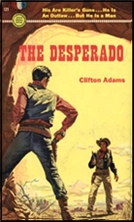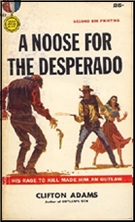Sat 19 Mar 2022
A Western Review by Tony Baer: CLIFTON ADAMS – The Desperado / A Noose for the Desperado.
Posted by Steve under Reviews , Western Fiction[7] Comments
CLIFTON ADAMS – The Desperado / A Noose for the Desperado. Stark House Press, trade paperback, 2017. // The Desperado. Gold Medal #121, paperback original, 1950. // Noose for the Desperado. Gold Medal #683, paperback original, 1957.
First heard about this via George Tuttle’s defunct website defining noir and suggesting some titles:

He says there: “The Desperado by Clifton Adams … though a Western, this novel is a landmark of early Gold Medal noir. Set in Texas during Reconstruction, the story traces the subtle transformation of Talbert Cameron from battler of injustice to outlaw.â€
Never before having thought of westerns as part of the noirboiled genre, this way eyeopening and provided this bibliomaniac with a whole new reading source to plunder.
Though westerns seem like they are 1800’s rather than 1940’s, the genre started around the same time as noirboiled crime, involved many of the same writers, and contains many of the same themes and styles as the Hammett’s and Chandler’s whose bibliographies I’d exhausted.
The lone gunman, the town harlot, and the marshall of the western are fairly transposable to the hardboiled detective, Jim Thompson psycho, and the femme fatale. The town always corrupt.
The Stark House edition I read has the following Donald Westlake quote on its cover:
“A compact, understated, almost reluctant treatment of violence, first introduced me to the notion of the character adapting to his forced separation from normal society.†Sounds like the Desperado’s the Parker template.

Onto the books themselves (in a recent read (Blue of Noon) a female character says: “Get to the point. I never listen to prefaces.â€).
Talbert (“Tallâ€) Cameron is around 18 years old, with a temper, in small town Texas during reconstruction. His folks have a little homestead, raise cattle and horses. It’s all real homey.
But then Talbert punches a carpetbagging cop who insults the local ladies, and he’s due to do time on the work gang.
He ain’t going.
He takes off, and when the cops beat his dad to death when his dad refuses to squawk of Tall’s whereabouts, all bets are off.
Tall comes back, exacts his revenge, and from there on out he’s a desperado.
It’s well written. It’s hard. It’s dark. It’s boiled.
The Desperado is quite good. Quite archetypal. Innocence lost. Young love. Honor. Revenge. Betrayal.

And like the typical hard-boiled detective, he’s got an ethos. He doesn’t steal. He only kills in self-defense.
And then comes the sequel: A Noose for the Desperado.
First of all: Spoiler alert: No Noose. Not even the suggestion of a noose.
He takes over a western version of Poisonville for no apparent reason than greed.
Now, for some unexplained reason, the Desperado has lost his morals. Or at least traded them for ambivalence.
He’s like Yogi Berra’s old saying that if you see a fork in the road, take it.
He steals. And then he decides that money doesn’t matter. He uses people. And then he looks after them. And then he doesn’t.
One of the main Aristotelian virtues is constancy. It’s a virtue all the great heroes have.
The Desperado has it in the first novel and loses it in second.
While he escapes the noose, we do not.
March 20th, 2022 at 1:08 am
I prefer Adams Westerns to his mysteries generally, but they are certainly tough. Like Luke Short Adams Westerns are almost as tough as most writers mysteries.
March 20th, 2022 at 9:59 am
Filmed in 1954 with Wayne Morris, Jimmy Lydon,
Beverly Garland,Dabbs Greer, and Lee Van Cleef.
March 20th, 2022 at 10:29 am
Thanks, Dan. I see from IMDb that DESPERADO was filmed again as Cole Younger, Gunfighter in 1958, with Frank Lovejoy, James Best, and Abby Dalton. I’ll have to see if either one can be found online.
March 20th, 2022 at 10:58 am
Dan’s review of the movie: https://mysteryfile.com/blog/?p=49294
March 20th, 2022 at 11:40 am
From Donald Westlake’s introduction to the first hardcover edition of THE HUNTER (Gregg Press, 1981:
“[Peter] Rabe was not my only teacher, nor did I learn only from the tough crime novel. One of the early Gold Medals, a beautiful western by Clifton Adams called The Desperado (1950), a novel with that same compact, understated, almost reluctant treatment of violence, first introduced me to the notion of the character adapting to his forced separation from normal society. Peter Rabe, in book after book, refined that idea.”
In a letter, Westlake once told me he was also impressed by the opening of Akira Kurosawa’s YOJIMBO, in which Toshiro Mifune’s unemployed swordsman is unperturbed when, on approaching a ramshackle town, he encounters a mongrel dog with a man’s severed hand in its mouth.
March 20th, 2022 at 2:18 pm
Clifton Adams wrote many stories for the western pulps even though he came in as the pulps were dying off during 1947-1953.
If you google his name there is a link to a long article published in 2014 titled “Remembering Clifton Adams”. He died an early death at age 52.
March 20th, 2022 at 2:32 pm
This article is one that’s new to me. Thanks, Walker!
https://www.oklahoman.com/story/entertainment/books/2014/09/14/remembering-clifton-adams-an-oklahoma-author-all-but-lost-to-history/60799313007/